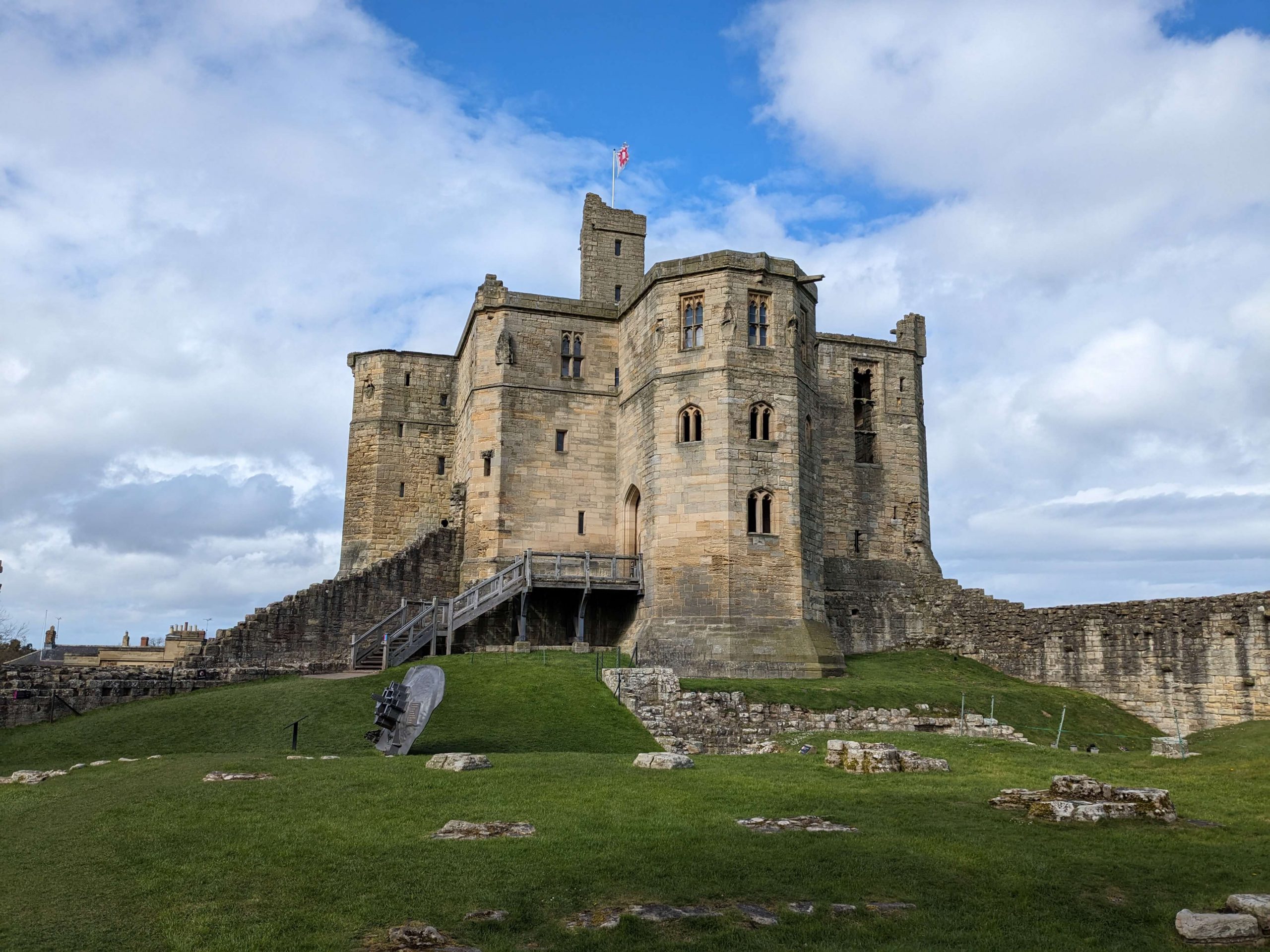Warkworth Castle is situated in the village of Warkworth in Northumberland, England. Founded in the 12th century, this magnificent mediaeval fortress served as a formidable stronghold for the Earls of Northumberland. Today it stands as a captivating ruin with a fascinating history to tell.
| Built | 21th Century |
| Type | Norman Castle |
| Condition | Ruinous – Major Stonework Intact |
| Maintained | English Heritage |
| Access | Public – Admission Fee |
| Postcode | NE65 0UJ |
Origins
While early history is extremely sketchy, it is likely that some kind of non-fortified settlement was established at Warkworth during the Anglo-Saxon period (mid 5th century to 1066) that would probably have belonged to the Earls of Northumbria. The founding of the castle itself didn’t occur until after the Norman Conquest of 1066.
Warkworth sits in a loop of the River Coquet, enclosing the village on the north, east and west sides with natural geographical defences. The castle was positioned to the south of the village within the narrow neck of the loop, in essence completing the settlement’s line of defence.
It is widely believed that Prince Henry, son of the King of Scotland, David I, was responsible for establishing a motte and bailey castle at the site in 1139, along with the first stone buildings. It was in this year that the peace Treaty of Durham between King Stephen of England and King David I of Scotland was established, as Stephen wanted to secure north England while civil war was erupting in the south west of the country. The treaty stipulated that in return for giving up control of the castles at Bamburgh and Newcastle, Prince Henry would become the Earl of Northumberland.
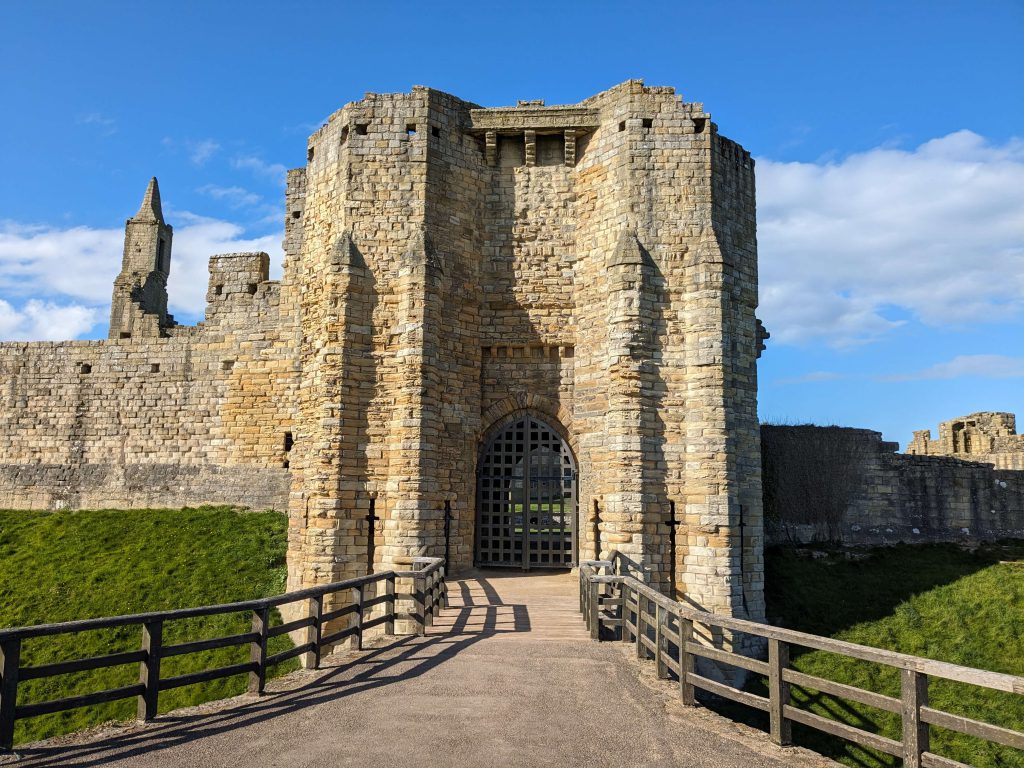
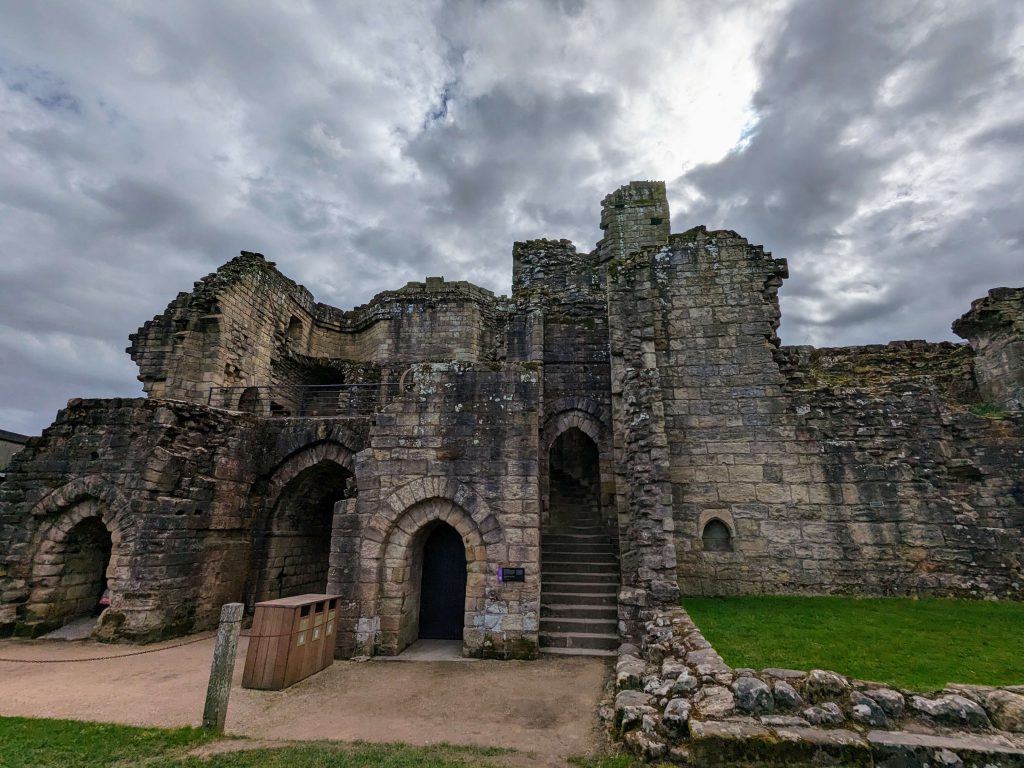
With that said, the actual first written mention of Warkworth Castle doesn’t come until nearly 20 years later in 1157 when it appears in the charter of 1157 to 1164. The charter loosely mentions that a castle and manor was granted to the prominent noble Roger fitz Eustace by Henry II. This could have meant that it had already been built during this time as it could have formed part of Henry’s reclaiming of Northumberland as other similar castles were built nearby.
On the other hand the term ‘castle’ could have just referred to a high-profile residence, central to the manor, and it was actually Roger who founded the castle later on.
What is more certain is that it was likely Roger’s son, Robert fitz Roger, who was responsible for starting the castle that stands today, with his son John completing it. The construction ran from 1199 to 1214 which would have comprised the gatehouse, the Carrickfergus Tower (at the south-west corner of the castle), the postern gate and the east curtain wall. The year before completion in 1213, Robert hosted King John at the castle – Robert was a very loyal favourite of the king.
The castle was passed down the family line throughout the 13th century, from Roger to his son John and to his son Roger. Roger died fairly young in 1249 and his one year old son, and heir, Robert, was too young to control the estate, so a guardianship was instated. William de Valence, the half-brother of King Henry III was appointed to this task but when Robert came of age, control was restored back to the family.
In 1290 the very young ‘Queen’ Margaret of Scotland was taken ill and died. Being so young, and with no direct successor, this created what is referred to as the Succession Crisis in Scotland, which resulted in 13 individuals rivalling for the throne. In an attempt to avoid plunging the country into civil war, King Edward I of England was asked to come north and arbitrate the proceedings. He did, but Edward went beyond just arbitrating, making a number of unpopular demands backed up by troop movements to the border.
This eventually led to the Anglo-Scottish Wars or the First War of Independence of 1296 – 1328 in which Robert and his son John de Clavering were involved in. They were both captured by the Scottish before being released in 1310, and John took control of his fathers estates. The long running war resulted in a lot of northern English castles, such as Warkworth, receiving money from the Crown for maintenance as they played an important role in the war. Warkworth was besieged by the Scottish in 1327 but they failed to capture it.
The Percy’s
An emerging influential family
John de Clavering died in 1332 and even though he had previously arranged in 1311 that the king would inherit his property on his death, King Edward III had already granted the castle to Henry Percy, second Baron Percy.
The Percy family were establishing themselves as one of the most important and influential families in the North of England. They had previously purchased the castle and barony of Alnwick in 1309 which had been their primary holding up to this point. Despite Alnick being a much more distinguished estate, Percy decided to make Warkworth the family’s primary residence which continued until the 17th century.
Little changed at Warkworth until Henry, 4th Baron Percy was made 1st Earl of Northumberland in 1377. He began work transforming the castle, with one major aspect being the construction of the great tower. This magnificent structure, shaped as a Greek cross, was likely built to celebrate Henry’s title, power and status as a great landowner in the north. The tower’s construction demonstrates the typical characteristics of North East architecture of the time, sharing similarities with other northern castles at Bolton and East Gilling. These likenesses strongly suggest that mason John Lewyn was responsible for the work.
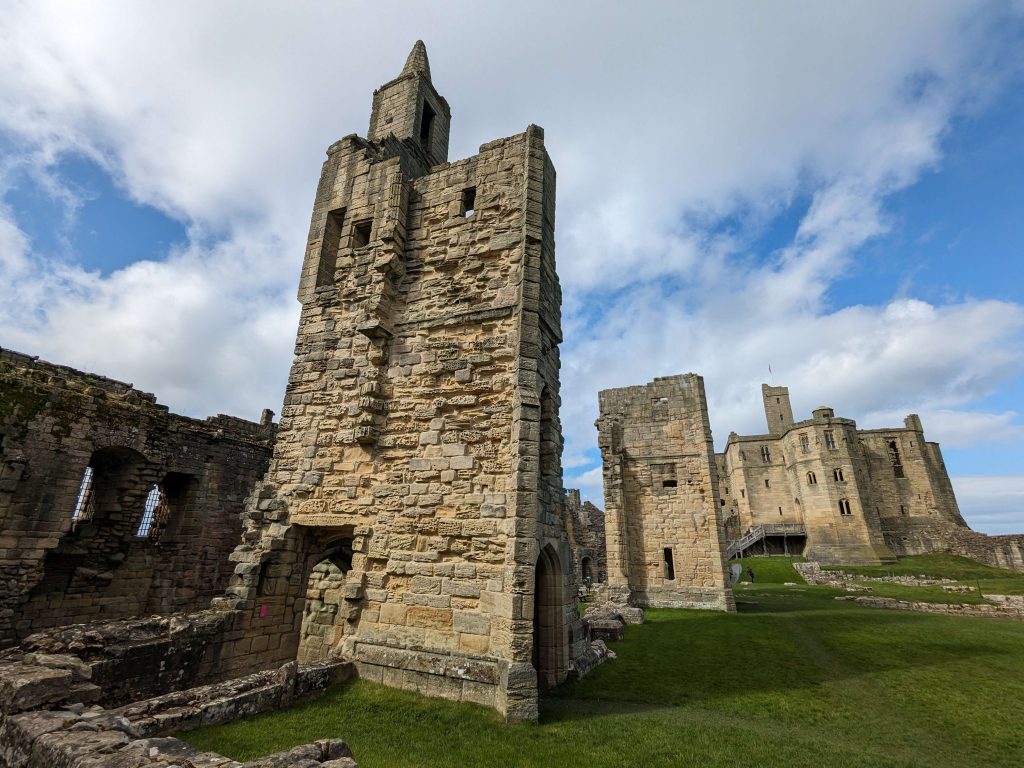

Percy Rebellion
Some years later, in 1399, King Richard II was deposed by his cousin Henry Bolingbroke. This was primarily due to Richard’s rule becoming erratic and ill-judged. Henry Percy, 1st Earl of Northumberland, was heavily involved in this deposition which resulted in Henry Bolingbroke taking the throne as Henry IV.
Henry IV’s reign featured numerous rebellions including one that was led by Henry Percy and his son Henry, famously known as Harry Hotspur. The Percy family became more and more dissatisfied with the king, fueled by a number of grievances and disagreements which included insufficiently being rewarded for the costs the family had provided for supporting the deposition, and lack of payments for the resources put into defending the English-Scottish border. It was in these border campaigns where Harry Hotspur earned him his name ‘Hotspur’ from the Scottish, a tribute to his effective commitment to the cause.
In 1403 Hotspur was killed at the Battle of Shrewsbury, when leading his rebel army against the army of Henry IV. When Hotspur’s father, the earl, learnt of this he fled to Warkworh. The earl was eventually arrested with the announcement that his property would be seized by the king. However this proved difficult as when Henry IV’s officers arrived at the Warkworth, they were met by the earl’s 14 year old son who declared his loyalty to the king. He didn’t have the authority to surrender the castle so quite remarkably it ended up remaining with the Percy family.
Just a year later in 1404 Henry Percy was pardoned, but the earl soon continued to show his discontent with the king. In 1405 Percy joined an unsuccessful rebellion against the king, led by the Archbishop of York, Richard Scrope. Scrope’s rebellion was swiftly crushed and quickly Henry IV then sent his army north. As it approached, Henry Percy fled across the border into Scotland. His castles briefly resisted the royal forces but they did soon capitulate, with the captain of Warkworth Castle reportedly surrendering after the first few shots from the royal forces’s cannons.


Wars of the Roses
With this latest dishonour, the Percy family’s properties were taken by the Crown. Unlike the previous failed seizure, Warkworth was occupied by John of Lancaster who was one of Henry IV’s sons.
After Henry V came to the throne in 1413, a few years later in 1416 the Percy estates were once again restored to the family. The earldom was also restored, with Henry Percy, the son of Harry Hotspur, becoming the second earl of Northumberland. The earl took up residence at Warkworth, and through vague documents of the time we know did undertake some building work at the castle, however it is unclear exactly what this consisted of.
During the Wars of the Roses, the Percy family supported the House of Lancaster and Henry VI. Henry, 2nd earl was killed during the start of the war at the Battle of St Albans in 1455. His son who became the 3rd earl, and who was also called Henry, met the same fate, being killed at the Battle of Towton in 1461.
Following these defeats Henry VI was deposed and Edward IV took the throne becoming the first Yorkist king that same year. Warkworth Castle was taken away from the Percy family and the Yorkists used it as their headquarters with the earl of Warwick overseeing operations as leader of the Yorkist forces. Attacks were made simultaneously on different Lancastrian castles including Bamburgh, Alnwick and Dunstanburgh.
With Henry 3rd earl of Northumberland previously killed in battle, Edward IV gave the earldom to John Neville, Lord Montagu, the brother of the earl of Warwick. During his time as earl from 1464 – 1469, he likely ordered the construction of Montagu tower in the south-east corner of the bailey. The tower was likely built as living space, accommodating more senior members of the household.
In 1470-1471, Edward IV restored the title and inheritance back to the Percy family and to the 3rd earl’s eldest son, Henry. As the 4th earl, records suggest he did stay at Warkworth, keeping the castle in good order and going on to begin the remodelling of the bailey. He also decorated the Lion Tower with his heraldry. But in 1489 the earl was murdered, possibly due to his previous decision to not commit his forces at the Battle of Bosworth in 1485. This played a significant role in the defeat of Richard III and subsequent ascension of Henry VII, the first Tudor king.
Decline
Warkworth Castle continued to be passed down the family line after the 4th earls murder. The 5th and 6th earls continued to maintain and repair the existing buildings and some walls were rebuilt.
The 6th earl, Henry, died in 1537 with no heirs and his brother had been executed the previous year for his part in the Pilgrimage of Grace (a revolt that occurred in the northern counties against the rule of Henry VIII). Once again the Percy estates went to the Crown.
Various royal officers, appointed by the Crown, used Warkworth Castle while overseeing the regions of the Anglo-Scottish border. However the majority of them were not prepared to pick up the bill for repairs, and by 1550 the castle was described as being in a state of disrepair.
Eventually the 6th earl’s nephew, Thomas Percy, was granted the family estates and earldom. Initially he carried out a number of repairs to the castle, but Thomas had bigger plans to reorder the castle as a report claimed that the hall and houses of office were taken down in readiness for their reconstruction. Progress soon halted though as Thomas was involved in the unsuccessful Rising of the North, a revolt of the Catholic northern earls in which they tried to depose Queen Elizabeth I and replace her with Mary, Queen of Scots.
After this failure, Warkworth Castle was sacked by Sir John Foster, Warden of the Anglo-Scottish border and in 1572 Thomas was executed and once again the Percy inheritance was passed over to the Crown. In 1574 Thomas’s brother, Henry Percy, was given permission to inherit the family estate and earldom, becoming the 8th earl of Northumberland, by which point parts of the castle were quite ruinous.
In 1585 it passed onto Henry Percy, the 9th earl. Henry was later imprisoned due to his connections with Thomas Percy, one of the schemers of the infamous failed Gunpowder Plot of 1605 – the attempt to blow up the House of Lords. As a result Warkworth Castle was leased to Sir Ralph Gray who had no interest in looking after it, so the castle was left to decay further.
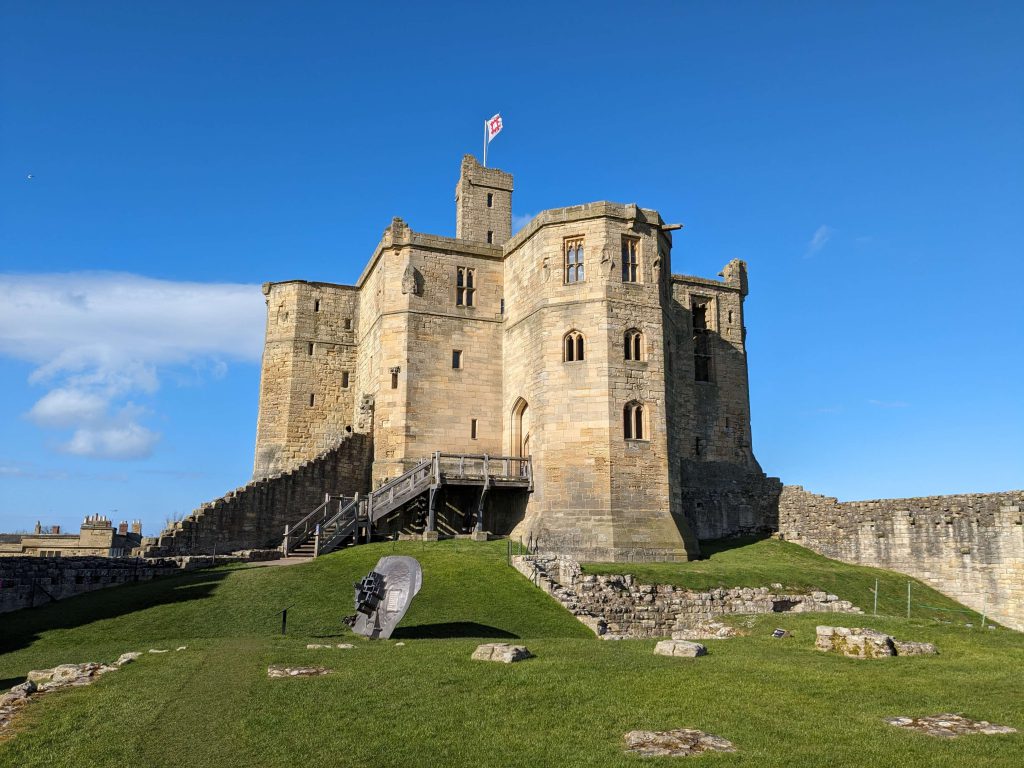
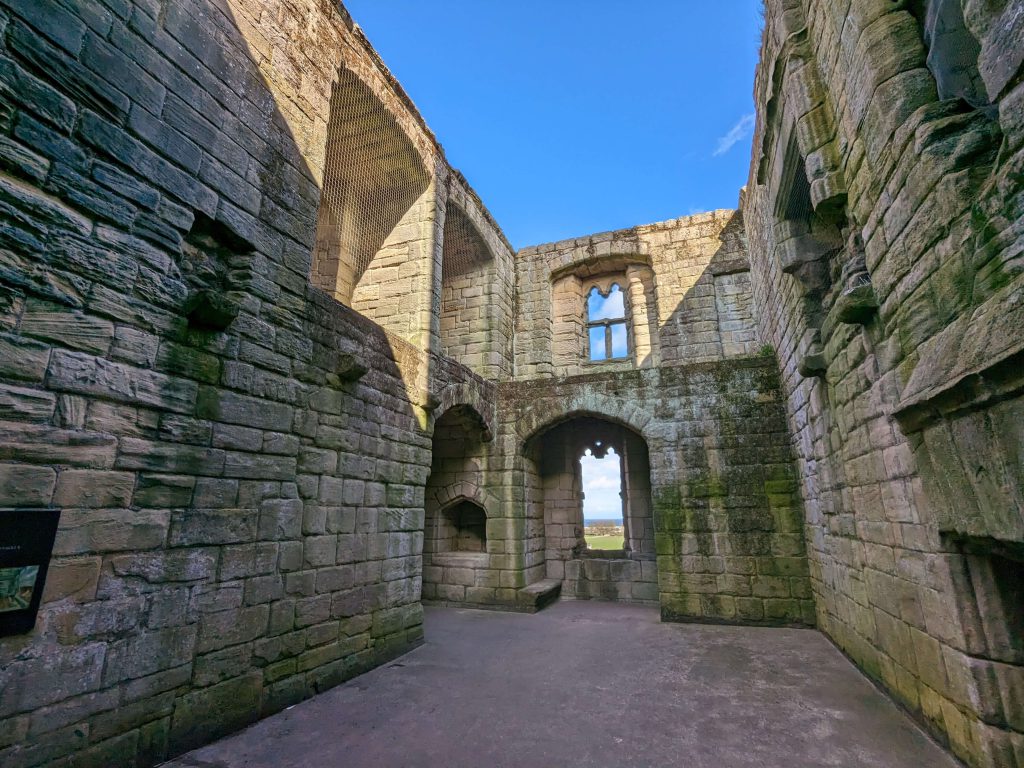
English Civil War
At the outbreak of the English Civil War (1642-1651), King Charles I’s forces held Warkworth Castle. Due to the long running war between England and Scotland, the Scottish were able to capture the castle in 1644, after forcing the Royalist garrison to surrender. Being sympathetic to the Parliamentarians the Scottish left the castle to Parliament who installed a garrison of their own in 1648.
During this time the castle would have sustained further damage due to the ongoing fighting, and when the Parliamentarian forces eventually pulled out, they removed the castle’s doors and iron so that the castle could no longer be used for military purposes. It is also possible that the bailey was purposely partially damaged which could account for the condition we see it in today. This process, known as slighting, happened to a great number of castles after the Civil War. The 10th earl, Algernon Percy tried to get compensation for the damage but was unsuccessful.
Later History
The castle continued to be neglected through the next century. The wall between the Montagu Tower and the gatehouse was dismantled so that the stone could be repurposed for the construction of cottages, and the Carrickfergus Tower at the south-west corner of the castle partially collapsed. Despite the dilapidated state, by the end of the 18th century Warkworth Castle started to attract tourists.
The Percy family, by now with their peerage elevated to dukedom of Northumberland, found a re-gained interest in the castle, putting money in for rebuilding the castle wall and clearing the site. In the 1850s the architect Anthony Salvin, considered an expert on mediaeval buildings, was brought in to restore the great tower.
In 1915 the castle was made a scheduled ancient monument and then in 1922 was handed to the state to conserve and maintain, while the Percy family still owned it. Today English Heritage manages the site, now classified as a grade 1 listing building, and is open to the public for a fee.
Ghost Stories
Not only does Warkworth castle have a rich history, it also has its share of ghost sightings with visitors reporting the sense of feeling uneasy when walking around the ruins.
The grey lady, believed to be the ghost of Margaret Neville from the House of Neville, a rival of the Percy family, has been seen wandering around the castle’s towers.
There have also been sightings of the spirit of an unknown young man running along the castle walls.

